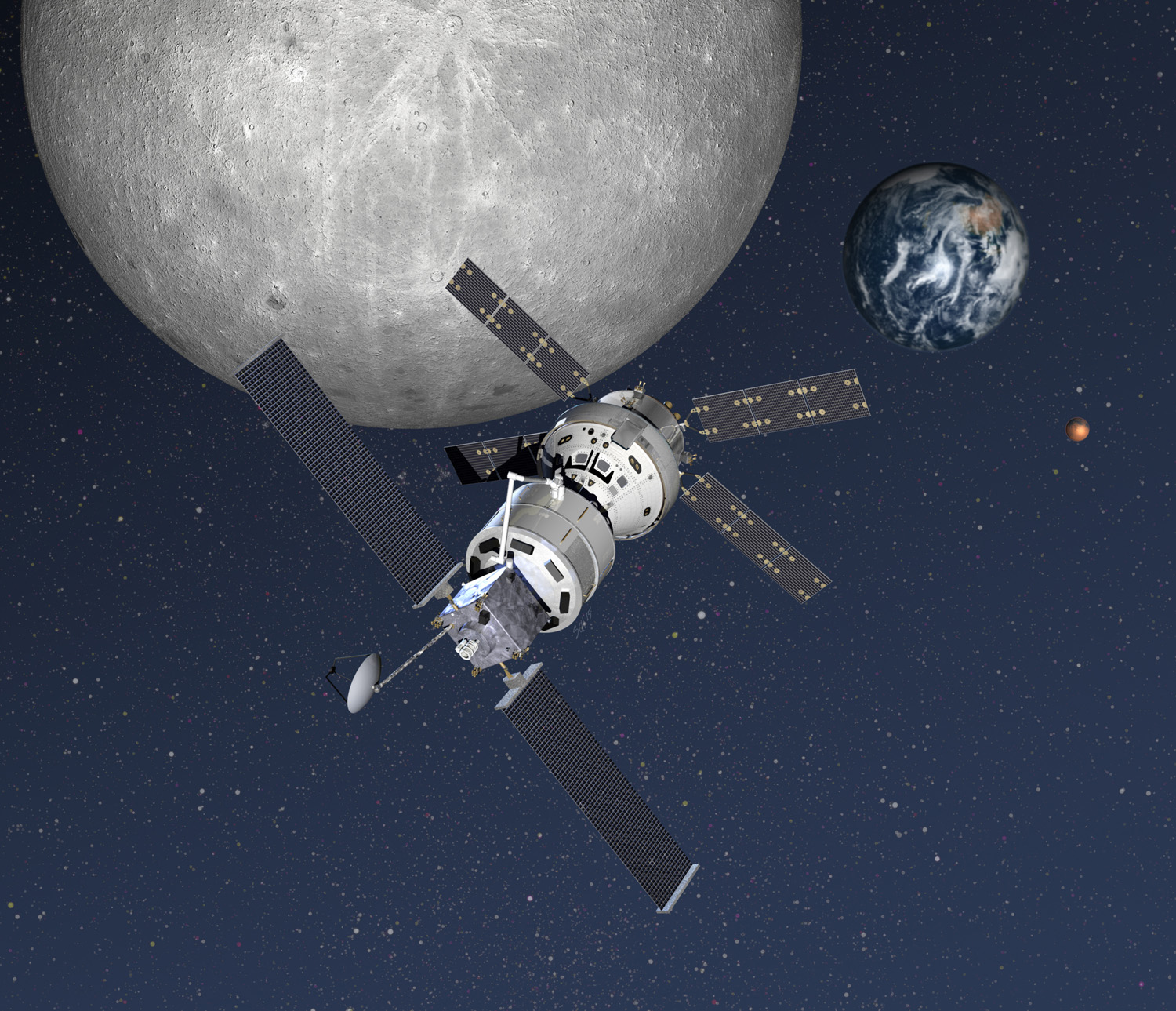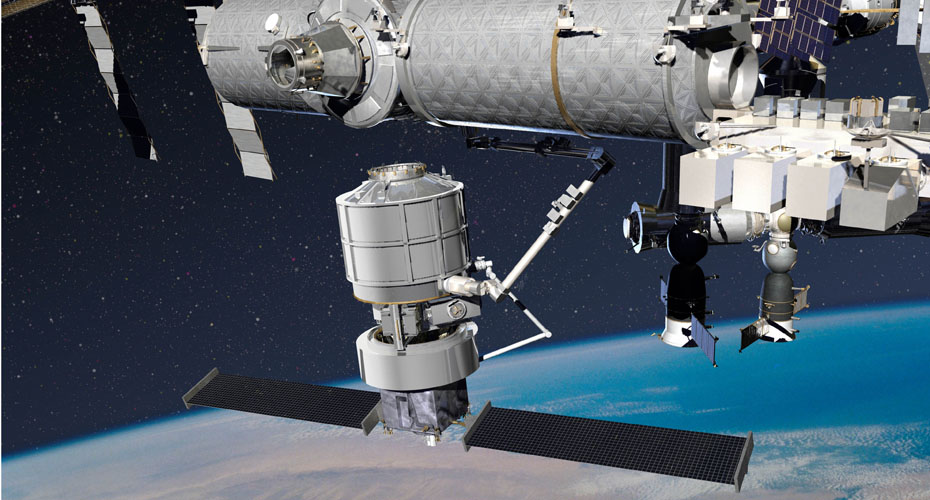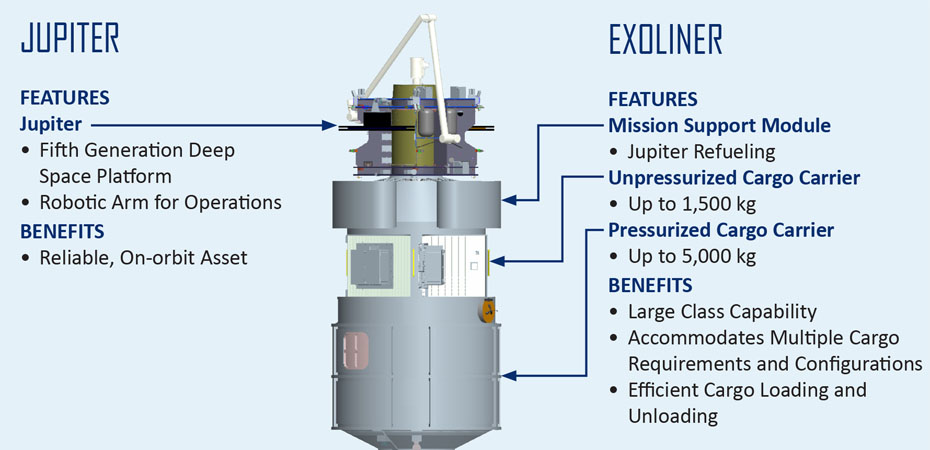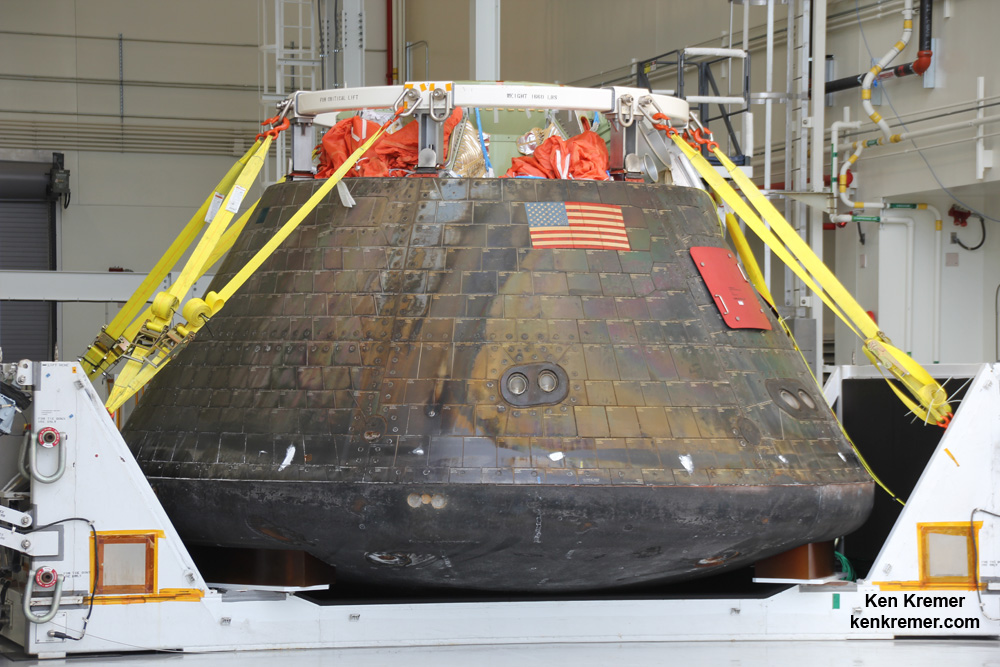Lockheed Proposes Dual Use ‘Jupiter’ Space Freighter for Station Resupply and Deep Space Exploration

Artist’s
concept shows Jupiter spacecraft and Exoliner cargo carrier with NASA’s
Orion crew capsule in a Lockheed Martin dual use conceptual proposal
for commercial missions to resupply the International Space Station
(ISS) and deep space exploration missions to the Moon and Mars. Credit:
Lockheed Martin
In the case of Lockheed Martin, managers unveiled “Jupiter” in what amounts to a dual use space freighter proposal that simultaneously meets NASA’s ongoing requirements for periodic station resupply as well as augmenting NASA’s Orion crew capsule with an evolvable container design that serves as the foundation for an enlarged pressurized area that would enable future deep space journeys by astronauts to the Moon, asteroids, and Mars.
Jupiter is designed to operate both in low-Earth orbit (LEO) and, rather ambitiously, to far-flung destinations beyond-Earth orbit (BEO) such as in cislunar space and all the way out to the Red Planet.
Lockheed is proposing an innovative multi-component architecture leveraging existing hardware into a new space vehicle they hope will create new commercial business opportunities. The concept was announced by Jim Crocker, vice president and general manager of Lockheed Martin Space Systems International, at an invited media briefing on March 12 which included AmericaSpace.
The three-part system includes the “Jupiter” propulsion and servicing spacecraft bus and “Exoliner” cargo carrier, and is supplemented with its own robotic arm.
Lockheed describes Jupiter as an “Innovative repurposing of existing capabilities with proven reliability and mission success.”
All three components are based on existing, flight-proven hardware to meet NASA’s needs to make it affordable, reliable, and robust, and the program includes international partners from Italy and Canada.

An
illustration showing Lockheed Martin’s solution for NASA’s Commercial
Resupply 2 Program. This image shows the Jupiter spacecraft, the
Exoliner cargo container and the robotic arm docking to the
International Space Station.
“It could also launch aboard the SLS. It fits in the SLS stack under the Block 1 version of the SLS.”
“Jupiter” is a propulsion module based on Lockheed’s own MAVEN interplanetary spacecraft, which is currently orbiting Mars. And it includes heritage from a total of eight successful interplanetary spacecraft launched since 2000, including the Juno mission hurtling to the planet Jupiter and the upcoming OSIRIS-REx asteroid sample return mission currently being assembled at Lockheed’s Denver facility.
It would function as a space tug.
“Jupiter is reusable and can be refueled several times,” Crocker told AmericaSpace.
“It can provide commercial service on a routine basis.”
The “Exoliner” is a cargo module derived from the unmanned ATV cargo carrier designed and developed originally for the European Space Agency (ESA) by Thales Alenia Space in Italy. The ATV flew five times to the station and just completed its final resupply mission. The ATV design is also already being modified by ESA to serve as the service module for NASA’s Orion crew capsule.
Exoliner is huge and much like an ISS module. It measures 14 feet (4.4 meters) in diameter and 30 feet (9.7 meters) in length.
“The station astronauts say it is like having another room,” said Wanda Sigur, vice president and general manager of Lockheed Martin Space Systems Civil Space line of business.
The carrier is comprised of both unpressurized and pressurized sections, similar to but much more voluminous than the SpaceX cargo Dragon currently supplying the ISS.
“It can carry about 5000 kg in the pressurized section,” Crocker explained to AmericaSpace. Up to 1500 kg can be carried in the unpressurized section.

Schematic shows Lockheed Martin proposal for Jupiter spacecraft and Exoliner cargo carrier. Credit: Lockheed Martin
“MAVEN is the heart of Jupiter and the 19th interplanetary success in a row of Lockheed Martin technology,” said Sigur.
“It involves proven systems and reusing designs, providing solutions for NASA.”
“We know how important it is to get astronauts on the ISS the supplies they need on time, every time,” said Sigur.
“Our approach is designed to deliver a large volume of critical supplies and cargo with each flight, and do so on schedule. That’s why we’re bringing together flight-proven technologies that are reliable, safe and cost-effective.”
And unlike any of the station’s current cargo resupply systems, the Jupiter propulsion system can detach from the cargo module and avoid disposing of expensive and valuable avionics equipment after each mission.
It will stay in orbit to be reused on the next mission, rather than being incinerated during the fiery reentry into Earth’s atmosphere.
“Jupiter is like the locomotive, Exoliner is the train and the MDA arm is the coupling between the two,” explained Crocker.
On the first launch, all three components would fly on the Atlas V. Subsequently, only the Exoliner cargo carrier would fly to low-Earth orbit.
The Jupiter module and robotic arm would then detach from the station and rendezvous with the next Exoliner, packed with cargo and attached to the Atlas rocket’s Centaur upper stage. The robotic arm would reach out and grapple the Centaur stage. It would then swap out the old and new Exoliners.
Jupiter would then fly back to rendezvous and dock at the station with the newly launch Exoliner. The Centaur then guides the old, trash-filled Exoliner to burn up upon atmospheric reentry.
Lockheed
Martin’s Jupiter and Exoliner would launch on a United Launch Alliance
Atlas V rocket similar to the one used for the MMS launch on March 12,
2015, from Space Launch Complex-41 at Cape Canaveral Air Force Station,
Fla. Credit: Ken Kremer/kenkremer.com/AmericaSpace
SpaceX and Orbital ATK hold the current CRS-1 cargo contracts from NASA, which involve 20 cargo delivery runs through at least the end of 2016. Both companies are believed to have submitted proposals for the CRS-2 contracts.
SpaceX has completed five of 12 operational Dragon cargo missions. Orbital ATK has completed two of eight. The third mission was destroyed during the Orb-3 launch catastrophe in October 2014.
New cargo bidders for CRS-2 in addition to Lockheed include Boeing, with a stripped-down version of their manned CST-100 capsule, and the Sierra Nevada Dream Chaser, which lost out in the bid for NASA’s commercial crew program (CCP) awarded in September 2014. The CRS-2 submissions are due by March 21, 2014.
The CRS-2 contract is valued at between $1.0 billion and $1.4 billion per year, and NASA requires this service from 2017 through 2024, according to the RFI.
NASA expects delivery of 14,250 to 16,750 kilograms per year of pressurized cargo as well as 1,500 to 4,000 kg per year of unpressurized cargo and return or disposal of up to 14,250 to 16,750 kg per year of pressurized cargo.
Crocker noted that the contract award winners are expected to be announced in June 2015.
“Our top priority is safe, reliable and affordable delivery of cargo to the ISS,” said Crocker. “At the same time, as NASA continues on the journey to Mars, we’re excited by the possibilities CRS-2 can offer to accelerate that goal.”
“Lockheed has selected an international team for an international mission,” noted Sigur.
What sets “Jupiter” apart from the other company proposals is its evolution and adaption to NASA deep-space human missions.
Although NASA is developing the Orion crew module, it will have to be supplemented with additional cargo, science, and living and propulsion modules to actually enable and conduct those astronauts’ journeys to destinations including the Moon, asteroids, and the Red Planet.
Jupiter and the Exoliner cargo carrier can be pre-positioned with supplies of food, fuel, water, and equipment for astronauts to use as they travel on manned missions farther into space than ever before, says Lockheed.
“Our priority is servicing the ISS. We are designing this system for deep space missions,” explained Josh Hopkins, space exploration architect for Lockheed Martin.
“NASA can use this design earlier and cheaper. This involves developing a small habitat near the moon for the astronauts to use in cis lunar space that is one week away. It will also enable longer and further journeys.”

Homecoming
view of NASA’s first Orion spacecraft after returning to NASA’s Kennedy
Space Center in Florida on Dec. 19, 2014, after successful blastoff on
Dec. 5, 2014.
“Its size can accommodate large things like a treadmill and environmental recycling systems.”
“We are providing hardware and a financial model that will allow the exploration of deep space,” explained Hopkins.
For more on Orion, read the AmericaSpace story about lessons learned from Orion EFT-1 here and here.
Read about changes to the Orion heat shield here.
Read about the re-flight of the EFT-1 capsule on the Ascent Abort-2 (AA-2) mission here. It’s due to launch atop a Peacekeeper missile from Space Launch Complex 46 SLC-46) at Cape Canaveral Air Force Station.
Stay tuned here for continuing updates on Orion and more.